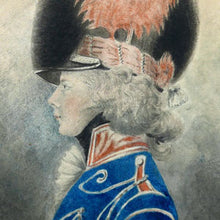Portrait Miniature of an Officer of the 16th Light Dragoons, 1795
- Regular price
- £2,400
- Sale price
- £2,400
- Regular price
-
- Unit price
- /per
Adding product to your cart
Overall: 20cm (8in) x 18cm (7.1in)
Watercolour on paper. Quarter length profile portrait of officer thought to be Colonel Lord Paget facing right in uniform; comprising light dragoon Tarleton helmet with regimentally specific scarlet turban, 1784 pattern blue coat with silver lace and scarlet facings. Attributed to John Downman ARA (Welsh, 1750-1824). Contained in period gilt moulded glazed frame. Indistinctly inscribed verso. Oval size: 9.5cm x 12cm.
At the outbreak of the French Revolutionary Wars, Lord Paget, heir to the 1st Earl of Uxbridge, was twenty-five years-old and a Member of Parliament when he raised a regiment of Staffordshire volunteers which he led with the temporary rank of lieutenant-colonel-commandant in the Flanders Campaign of 1794. He was formally commissioned into the British Army as a lieutenant in April 1795 and was rapidly promoted to lieutenant-colonel by the end of the following month. He was appointed to the command of the 16th Light Dragoons two weeks later on 15 June 1795. Thus were the origins of Paget’s military career that would culminate twenty years later in the loss of his right leg while commanding Wellington’s cavalry at Waterloo.
Read more
John Downman (1750-1824), the son of a lawyer, was born, like Paget, in North Wales. He received early artistic training in Liverpool, and in 1769 entered the newly formed Royal Academy Schools where he was taught by Benjamin West. He continued his education in Italy, travelling with Joseph Wright of Derby, and was in Rome from 1773 to 1774. From 1777 to 1778 he was at Cambridge, where he began his career as a portrait painter. From 1779 to 1804 he was settled in London, firstly at a studio in Bedford Street, Covent Garden, thence at increasingly fashionable addresses, including Bond Street, Jermyn Street and Piccadilly, where the aristocratic and fashionable flocked to his door. His style was especially suited the taste of the age; and he drew many of the foremost beauties of his day, including Georgiana, Duchess of Devonshire and the actress Sarah Siddons. It has been said that ‘his study of classical art in Italy is apparent in his austere, delicate lines and his habit of placing sitters in cameo-like profile.’ He later life he moved to the West Country. In 1806, he married in Exeter, but left after his wife died in 1808. He was again mainly in London before settling in Chester in 1817. However, he died in Wrexham, having returned to his native Wales.








